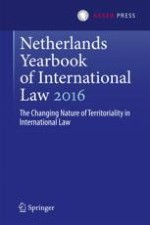2017 | OriginalPaper | Chapter
4. Cartographies of the Present: ‘Contingent Sovereignty’ and Territorial Integrity
Author : Sara Kendall
Published in: Netherlands Yearbook of International Law 2016
Publisher: T.M.C. Asser Press
Activate our intelligent search to find suitable subject content or patents.
Select sections of text to find matching patents with Artificial Intelligence. powered by
Select sections of text to find additional relevant content using AI-assisted search. powered by
